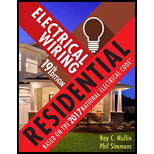
Electrical Wiring Residential
19th Edition
ISBN: 9781337101837
Author: Ray C. Mullin, Phil Simmons
Publisher: Cengage Learning
expand_more
expand_more
format_list_bulleted
Concept explainers
Question
Chapter 29, Problem 14R
To determine
Mention the common term to utilize the electricity in lower rates by certain hours of the day.
Expert Solution & Answer
Trending nowThis is a popular solution!

Students have asked these similar questions
5) Find the value of voltage V, and V₂ using Loop
analysis.
5A
+
4 34
ww
8
2
www
3A
m
4
38
+
23V₂
1/2
+
±) 12V
4) Find the valve of voltage Vx using Loop analysis.
2A (
1
3
w
+
234
OV
+
123
3 Write but do not solve the set of Loop equations
for this circuit
www
4
१ह
15
ww
5
124
+
☹
33
M
7A
www
6
103
23
راح
+
Chapter 29 Solutions
Electrical Wiring Residential
Ch. 29 - Prob. 1RCh. 29 - a. What is the unit load per ft2 for the general...Ch. 29 - a. What is the ampere rating of the circuits that...Ch. 29 - Why is the air-conditioning load for this...Ch. 29 - What demand factor may be applied when four or...Ch. 29 - What load may be used for an electric range rated...Ch. 29 - What is the calculated load for an electric range...Ch. 29 - What is the calculated load when fixed electric...Ch. 29 - On what basis is the neutral conductor of a...Ch. 29 - Why is it permissible to omit an electric space...
Knowledge Booster
Learn more about
Need a deep-dive on the concept behind this application? Look no further. Learn more about this topic, electrical-engineering and related others by exploring similar questions and additional content below.Similar questions
arrow_back_ios
SEE MORE QUESTIONS
arrow_forward_ios
Recommended textbooks for you
 EBK ELECTRICAL WIRING RESIDENTIALElectrical EngineeringISBN:9781337516549Author:SimmonsPublisher:CENGAGE LEARNING - CONSIGNMENT
EBK ELECTRICAL WIRING RESIDENTIALElectrical EngineeringISBN:9781337516549Author:SimmonsPublisher:CENGAGE LEARNING - CONSIGNMENT Electricity for Refrigeration, Heating, and Air C...Mechanical EngineeringISBN:9781337399128Author:Russell E. SmithPublisher:Cengage Learning
Electricity for Refrigeration, Heating, and Air C...Mechanical EngineeringISBN:9781337399128Author:Russell E. SmithPublisher:Cengage Learning

EBK ELECTRICAL WIRING RESIDENTIAL
Electrical Engineering
ISBN:9781337516549
Author:Simmons
Publisher:CENGAGE LEARNING - CONSIGNMENT

Electricity for Refrigeration, Heating, and Air C...
Mechanical Engineering
ISBN:9781337399128
Author:Russell E. Smith
Publisher:Cengage Learning
What is an electric furnace and how does it work?; Author: Fire & Ice Heating and Air Conditioning Inc;https://www.youtube.com/watch?v=wjAWecPGi0M;License: Standard Youtube License